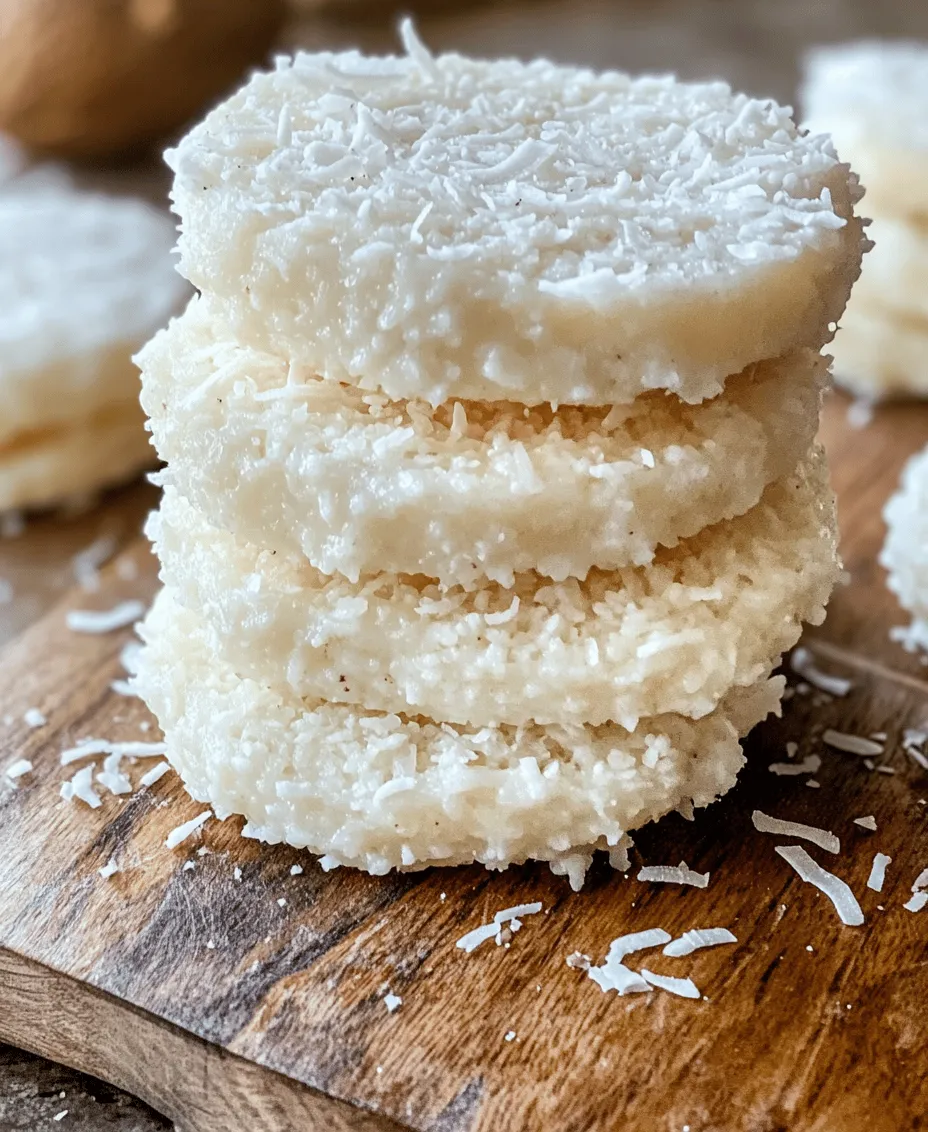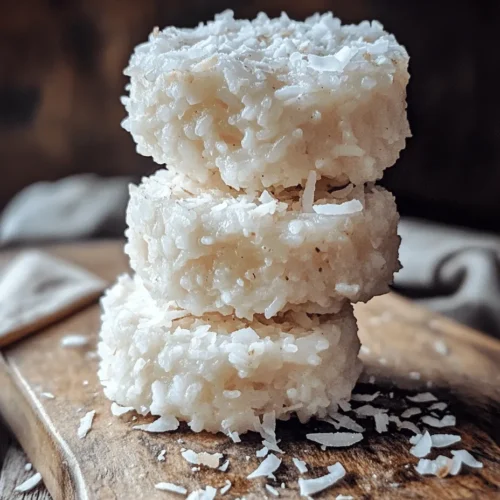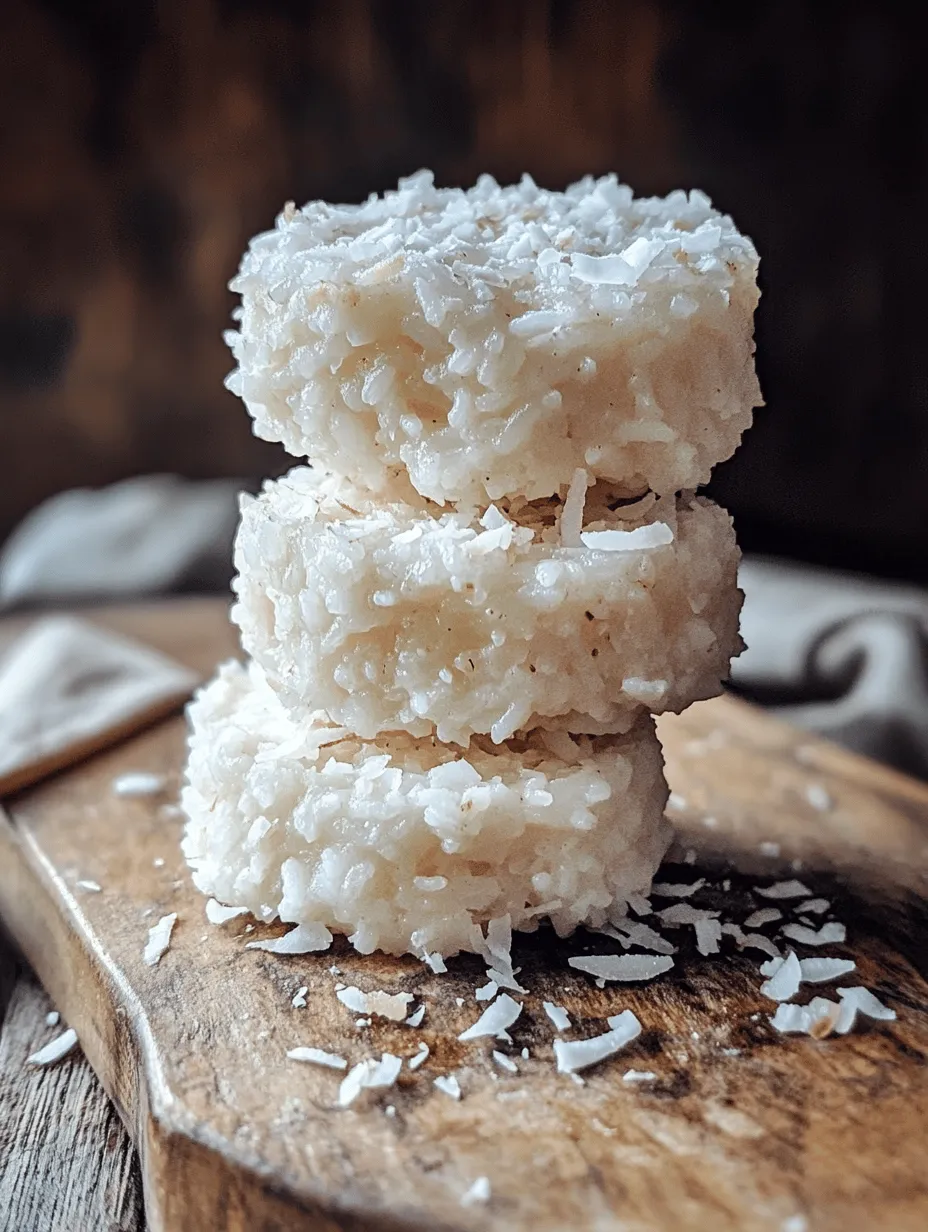Introduction
Coconut Rice Cakes Delight is a delightful fusion of flavors and textures that reflects the rich culinary traditions of tropical regions. This recipe captures the essence of coconut and the aromatic qualities of jasmine rice, creating a treat that is both comforting and exotic. Rice cakes have long been a staple in various cuisines around the world, from the crispy rice cakes of East Asia to the hearty rice cakes found in Latin American households. Their versatility allows them to be enjoyed in numerous ways: as a snack, dessert, or even a breakfast item.
The simplicity of this recipe is one of its most appealing features. With just a handful of ingredients, you can create a dish that is not only quick to prepare but also caters to a variety of dietary preferences, including gluten-free and vegan options. The warm, tropical flavors make it an ideal treat to share with family and friends, or to enjoy solo while dreaming of palm trees and sandy beaches.
The Charm of Coconut Rice Cakes
Rice cakes have a long history that dates back centuries. In Asian cultures, rice cakes have been used in festive celebrations and rituals, symbolizing prosperity and good fortune. The texture and taste of rice cakes can vary widely, depending on the cooking methods and ingredients used. In recent years, there has been a resurgence in the popularity of coconut-based dishes, likely due to the growing interest in plant-based diets and the nutritional benefits associated with coconut.
Coconut is celebrated for its versatility; it can be used in sweet and savory dishes alike. Coconut milk brings a rich, creamy texture to recipes, while shredded coconut adds a chewy bite that enhances the overall experience. Jasmine rice, with its floral aroma and slightly sweet flavor, complements the coconut beautifully, creating a symphony of tastes that transport you straight to the tropics.
In terms of nutrition, both coconut and jasmine rice offer numerous benefits. Coconut is rich in healthy fats, specifically medium-chain triglycerides (MCTs), which are known for their energy-boosting properties. Additionally, it contains fiber, vitamins, and minerals. Jasmine rice, on the other hand, is a type of long-grain rice that is low in fat and provides a good source of carbohydrates, making it an excellent fuel source for the body. Together, these ingredients create a dish that is not only delicious but also satisfying and nourishing.
Ingredients Breakdown
To make Coconut Rice Cakes Delight, you will need the following ingredients:
Jasmine Rice
Jasmine rice is a long-grain rice known for its delicate floral aroma and slightly sticky texture when cooked. It is the preferred choice for this recipe due to its ability to absorb flavors beautifully and its tender yet firm consistency. When cooked properly, jasmine rice provides a delightful chewiness that pairs perfectly with the creamy coconut milk. Additionally, it is gluten-free, making it suitable for various dietary needs.
Coconut Milk
Coconut milk is the star ingredient in this recipe, providing richness and a subtle sweetness that enhances the overall flavor. It is made from the flesh of mature coconuts and is a versatile ingredient in many cuisines, especially in Southeast Asian dishes. When selecting coconut milk, you may choose between full-fat or low-fat versions, depending on your dietary preferences. For those looking to reduce calories, low-fat coconut milk maintains a good level of creaminess while cutting down on fat content.
Shredded Coconut
Shredded coconut adds texture and a burst of coconut flavor to the rice cakes. You can find both sweetened and unsweetened varieties in stores. For a healthier option, unsweetened shredded coconut is recommended, as it allows the natural sweetness of the coconut milk and any added ingredients to shine through. This ingredient contributes to the delightful chewiness of the rice cakes, making each bite a flavorful experience.
Optional Additions
To elevate the flavor profile of your Coconut Rice Cakes Delight, consider adding sugar, vanilla extract, and cinnamon. Sugar can be adjusted to your taste, providing just the right amount of sweetness. Vanilla extract enhances the aromatic qualities of the dish, while a pinch of cinnamon adds warmth and depth. These optional ingredients allow you to customize the recipe to suit your palate, making it even more enjoyable.
Cooking Oil
While not a primary ingredient, a small amount of cooking oil is essential for greasing the molds or the pan you will use to shape the rice cakes. It helps prevent sticking and ensures that your rice cakes come out effortlessly. You can use any neutral oil, such as vegetable or canola oil, or opt for coconut oil for an extra hint of coconut flavor.
Step-by-Step Instructions
Rinsing the Rice
The first step in creating perfect Coconut Rice Cakes is rinsing the jasmine rice thoroughly. This important step removes excess starch from the rice, which can lead to a gummy texture when cooked. Rinsing the rice under cold water until the water runs clear is recommended. This process not only ensures a better texture but also enhances the flavor of the finished dish.
Cooking the Rice
Once the rice is rinsed, it’s time to cook it. In a medium saucepan, combine the rinsed jasmine rice and coconut milk, using a ratio of 1 part rice to 1.5 parts liquid for perfect results. While you can use water to adjust the consistency, the coconut milk will provide a richer flavor. Bring the mixture to a gentle boil over medium heat. Once boiling, reduce the heat to low, cover the saucepan, and let it simmer for about 15 minutes or until the rice absorbs all the liquid.
It is crucial to keep an eye on the temperature during cooking. If the heat is too high, the rice may cook unevenly or burn at the bottom. On the other hand, if the heat is too low, the rice may take longer to cook and can become mushy.
Cooling the Rice
After the rice has cooked, remove it from the heat and let it sit covered for an additional 10 minutes. This resting period allows the rice to steam and settle, resulting in a fluffier texture. Once the time is up, uncover the saucepan and fluff the rice with a fork, ensuring that it remains light and airy.
Flavoring the Rice
To infuse your Coconut Rice Cakes with delicious flavor, stir in any optional ingredients such as sugar, vanilla extract, and cinnamon at this stage. Adjust the sweetness to your liking by adding more or less sugar, and mix well until all the ingredients are evenly distributed. This step is crucial for balancing the flavors and ensuring that each bite is a delightful experience.
With the preliminary steps complete, you are now ready to move on to shaping and cooking your Coconut Rice Cakes. Stay tuned for the next part, where we will guide you through the process of forming the cakes and achieving that perfect golden-brown crust. Enjoy this journey into tropical flavors, and get ready to indulge in a delightful treat that celebrates the simplicity and beauty of coconut and jasmine rice!

Preparing the Molds
The first step in creating your Coconut Rice Cakes Delight is preparing the molds. Choosing the right type of mold is crucial for achieving the best texture and shape in your cakes. Silicone molds are often recommended for their flexibility, which allows for easy release of the cakes. Alternatively, you can use metal or plastic molds, but ensure they are well-greased to prevent sticking.
When it comes to greasing, opt for a light coating of coconut oil or cooking spray. Coconut oil not only adds flavor but also enhances the overall coconut experience of the rice cakes. Make sure to cover every corner of the mold to ensure the cakes pop out without a hitch. If you are using a traditional mold, consider lining it with parchment paper for extra insurance against sticking.
Shaping the Cakes
Once your molds are ready, it’s time to shape the cakes. Begin by taking the coconut rice mixture and spooning it into the prepared molds. The key here is to pack the rice mixture tightly. This helps the cakes hold their shape when they are unmolded. Use the back of a spoon or your fingers (dampened slightly to prevent sticking) to press the mixture down firmly.
For best results, ensure that the top of the mixture is level with the rim of the mold. This will give your rice cakes a uniform appearance. If you’re feeling creative, you can also experiment with different shapes using cookie cutters or other mold designs to add a unique flair to your coconut rice cakes.
Chilling Process
After shaping, the next crucial step is the chilling process. Chilling the rice cakes is vital for allowing them to set up properly. The cool temperature helps the starches in the rice firm up, resulting in a more solid cake that holds its shape during serving.
Place the filled molds in the refrigerator for at least 2 hours, or until they feel firm to the touch. If you’re short on time, a quick 30-minute chill in the freezer can also work, though be careful not to freeze them solid. Proper chilling not only helps with texture but also enhances the flavors, allowing the coconut and any added ingredients to meld beautifully.
Unmolding Techniques
Once the chilling process is complete, it’s time to unmold your coconut rice cakes. To do this safely without damaging them, gently run a knife around the edges of the mold to loosen the cakes. If you used silicone molds, simply flex the mold to release the cakes. For metal or plastic molds, you may need to tap the mold gently against the counter to help dislodge the cakes.
If you encounter resistance, do not pull or yank the cakes out; instead, give them a little more time in the mold or run the knife around the edges again. Once they are released, place them on a serving platter or individual plates.
Serving Suggestions
Coconut rice cakes can be enjoyed in various ways, making them incredibly versatile. Here are some serving suggestions to enhance your experience:
– Plain vs. Toasted: You can serve the rice cakes plain for a soft, chewy texture, or you can toast them on a skillet for a few minutes on each side. Toasting adds a delightful crunch and enhances the overall flavor.
– Pairing Options: Consider pairing the rice cakes with fresh fruits like mango, berries, or pineapple to add a refreshing contrast. For a savory touch, you can serve them with dips such as coconut yogurt or a tangy mango salsa.
– Presentation Ideas: Elevate your dish visually by stacking the rice cakes in layers, garnishing with shredded coconut, and drizzling with honey or maple syrup. Adding a sprinkle of chopped mint or edible flowers can bring a beautiful touch to the presentation.
Variations and Adaptations
To keep things exciting, you can create your own variations of coconut rice cakes. Here are some ideas:
– Tropical Fruit Additions: Incorporate diced tropical fruits, such as pineapple or mango, into the rice mixture before packing them into molds. This adds a natural sweetness and enhances the tropical flavor profile.
– Savory Twists: For those who prefer savory flavors, consider adding herbs like cilantro or spices such as cumin or curry powder. This adaptation transforms the rice cakes into a unique appetizer or side dish.
– Dietary Adaptations: Coconut rice cakes can easily be made vegan by ensuring you use plant-based ingredients. For gluten-free options, double-check that your rice and any additional ingredients are certified gluten-free.
Nutritional Information
Each serving of coconut rice cakes is not only delicious but also packed with nutritional benefits. Here’s an overview of the nutritional value per serving:
– Calories: Approximately 150-200 calories, depending on the size and specific ingredients used.
– Fats: About 5-7 grams of healthy fats primarily from coconut.
– Carbohydrates: Roughly 25-30 grams, providing energy and fiber.
– Protein: Each cake contains about 2-4 grams of protein, depending on the addition of any fruits or nuts.
Coconut rice cakes are rich in essential nutrients, including manganese, copper, and selenium. They also provide dietary fiber, which supports digestive health and helps maintain stable blood sugar levels.
Conclusion
Coconut Rice Cakes Delight are a testament to the joy of creating simple yet delicious dishes that resonate with cultural richness. Their versatility allows for numerous adaptations, making them suitable for any occasion, from casual snacks to elegant desserts.
Encouraging experimentation with flavors and textures empowers you to personalize this recipe to fit your taste. Whether enjoyed plain, toasted, or paired with delightful accompaniments, these rice cakes bring a taste of the tropics to your table.
Try making these coconut rice cakes at home and experience the satisfaction of crafting a dish that is not only tasty but also embodies the spirit of culinary creativity. Embrace the joy of cooking and the delight of sharing delicious food with loved ones.


